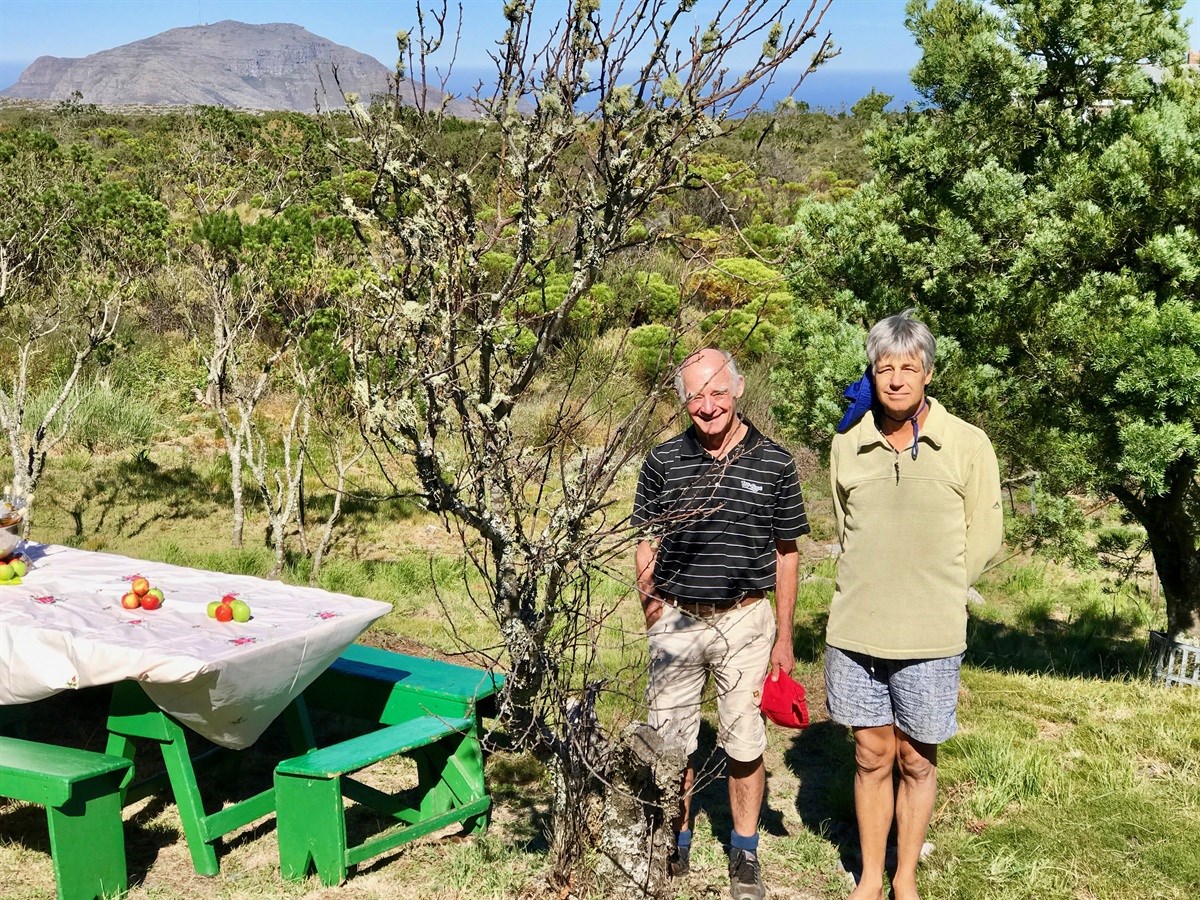






The as yet unidentified tree is understood to have been planted by the dam engineer, possibly over a century ago, as it was found in the front garden of what is now the South African Mountain Club hut but originally accommodated the dam engineer.
According to Tru-Cape’s New Varietal Expert Buks Nel, the modern-day apple originated in the Tien Shan mountains of Kazakhstan near the modern day Altamy (city of apples). These apples are regarded as the genetic source of all today’s apples.
Nel and Tru-Cape’s Quality Assurance Manager Henk Griessel teamed up to research ancient apples about which they published their book, Apples in the Early Days at The Cape. The two were also the force behind the planting of the Tru-Cape Heritage Orchard, now in its fourth leaf, at Oak Valley Estate in Grabouw. Griessel explains: “We wanted to preserve the genetic materials of South African apples and pears, no longer in commercial production, and at risk of being forgotten.”
“In our continued search for ancient apples and pears, we discovered that there is an apple tree at the very unlikely place on top of Table Mountain,” Griessel says.
Griessel and Nel were accompanied to the top of Table Mountain with a varietal expert from the SA Department of Agriculture, Forestry and Fishing, Hennie Venter. “It was a pleasant experience to go up the mountain and see the vegetation there,” Venter says and of the tree they found: “it certainly is a very old tree although we cannot say exactly how old. It might be younger than it looks as it has lived in very harsh conditions. The tree is almost growing horizontally as a result of the strong winds. It doesn’t appear to be a tree that I can identify,” he admits.
Took a hike up #TableMountain with @TruCapeFruit for a look at #SA's oldest #AppleTree! pic.twitter.com/WrclEQgU4D
— Bizcom Agriculture (@Biz_Agriculture) April 24, 2017
Griessel says we can look to history for a clue: “In 1723, Francois Valentijn reported seeing three apple trees in the Company’s Garden. One of them he named the Aagtenappel of which he says: "De aagtenappel zyn hier doorgans wel klein, doch zeer goed van smaak". We found the Aagten apple in the book of Knoop of 1758 which is also known as the Kroon appel. When we compare historic illustrations of the Aagtenappel we see many similarities to the fruit from the tree on top of Table Mountain.
Separately, Tru-Cape has also secured the Wijnappel, the first apple recorded in the diary of the first Dutch Commander of the Fleet and Settlement on April 17, 1662.
Nel says that Tru-Cape recently received a telephone call from a grower in Carolina, between Pretoria and Swaziland, who said that he’d read about Tru-Cape’s attempts to track down the Wijnappel through Dutch connections and wanted to say that he had the ‘Wijnappel’ in his garden.
According to Nel, the Dutch Wijnappel is currently in quarantine and will be planted in Tru-Cape’s Heritage orchard in 2020 while the Carolina apple will be investigated at the earliest opportunity.
In addition to the old apple tree in the front garden of the Mountain Club of South Africa hut, a stone and corrugated iron cottage at an altitude of 760m and 12 minutes walk from Kasteelspoort, on the top Table which is close to the Woodhead Reservoir and Waterworks Museum, a second, younger apple tree was found, most likely a seedling.
According to the Mountain Club, The Table Mountain hut was originally built for the Resident Engineer overseeing construction of the Woodhead and Hely-Hutchinson Reservoirs on the lower table. In 1904 when the dams were completed and the hut due to be demolished, the MCSA approached the Cape Town City Council and negotiated a lease agreement. The nominal rental of one Pound per annum was later dropped because it wasn’t cost-effective for the council to continue collecting it.
Roelf Pienaar, Tru-Cape’s managing director says that Apples in the Early Days at The Cape, tracks the history of mostly forgotten varieties. One of the challenges the authors experienced was the paucity of readily available information about historic plantings. He explained that when they discovered how few records of apple varieties planted in the Cape existed, they became aware of the overwhelming responsibility to preserve the knowledge and to ensure that when future generations look back to this century, they will have excellent records of the fruit we enjoyed.
Their research, over a two-year period, led Nel and Griessel to interview older growers who might have remembered varieties that are no longer propagated. The find of this apple tree on Table Mountain is a natural extension of the work that Griessel and Nel, and Tru-Cape as a whole, is doing to preserve our fruit history for the future.
Each April Tru-Cape marks the birth of the apple industry in the Cape, now part of a R6 billion agricultural sector. This year, on 23 April, Tru-Cape lead a hike up the mountain to visit the tree on top of Table Mountain and celebrated the 355 anniversary of the apple industry with a lunch in the Mountain Club hut.”